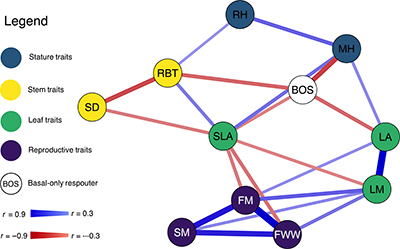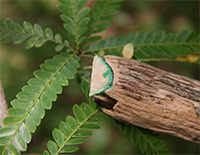Australian Journal of Botany
Volume 71
Number 8 2023
Time-delayed species loss in response to fragmentation associated with habitat clearance, is a conservation concern for management of biological diversity in the world’s fragmented landscapes. We found evidence of future species loss in some of the study communities. Banksia woodlands had 28% average loss (13 species per patch). Understanding how different community types respond to time-delayed impacts helps land managers to prioritise intervention efforts to pre-empt species decline and eventual extinction through conservation, management and restoration of remnant vegetation patches.
Fragmentation can interrupt many plant–animal interactions with lasting effects on plant populations. Silver banksia is a highly fragmented but functionally important tree species and important food plant for yellow-tailed black cockatoos. In this study, we document exceptionally high rates of seed predation, development-dependent failure of follicle release from discarded cones, and reduced seed fitness of discarded seeds in fragmented populations of silver banksia.
Chemical and isotopic analyses of lead in lichen and fungal herbarium collections were used to reconstruct patterns of deposition over a period of 150 years in eastern Australia. The central role of herbaria in two case studies of temporal changes in atmospheric lead pollution is discussed and used to address future collection management challenges. Photograph by Dr Xinyu Wang.
Climate change is causing novel forest disturbances that can mimic patterns created by historic disturbance agents. Following a heatwave-compounded drought event in south-western Australia, forest and tree die-off mimicked those caused by the exotic invasive root pathogen, Phytophthora cinnamomi. Our findings confirmed that the observed die-off was indeed caused by the extreme climate and not by P. cinnamomi. Photograph by George Matusick.
This study investigated seed biology and reproduction in the Geijera parviflora to inform conservation actions. Geijera parviflora is a species suitable for ecological restoration and ornamental horticulture, but has largely been overlooked because of issues with unreliable information on its seed biology and reproduction. The results of this study addressed several issues leading to poor seed germination and shed light on the previously unknown seed- storage behaviour of G. parviflora in both in situ and ex situ conditions. Photograph by Ganesha Liyanage.
The study of the ecology of native species in tropical environments offers a range of information about the development of forests, including more specific characteristics such as variations that can occur within a single species. Trees are very well adapted to this type of environmental variation such as flooding, but species can show very resilient responses and development to times of drought in these environments, even at young ages, demonstrating the importance of preservation and management of tropical native forests. Photograph by Rosana Feitosa.
Identifying patterns of geographical distribution of species can be an extraordinary tool to understand not only their biology, but also their own identity. With that in mind, we combined climatic data from south-eastern South America with information on the distribution of a group of species of difficult delimitationin an attempt to aid in their identification. Our results corroborated with findings from studies with different lines of evidence and indicated that geographical distribution is indeed invaluable to plant identification and classification. Photograph by Anderson Christ.
We studied correlation patterns among leaf, stem, stature and regeneration traits in 164 eucalypt taxa from southern Australia. Stem and habit were independent of reproductive traits and leaf traits were coordinated with most other traits. Post-fire regeneration behaviour was also coordinated with many traits. Phylogenetic analyses indicated that most of these patterns evolved repeatedly throughout the eucalypt radiation. Image by Antoinette Portelli.
Myrtle rust is a pathogen that threatens the family that forms the core of many Australian ecosystems: the Myrtaceae. Worse still, death and decline of myrtaceous species could have knock-on effects for the species that rely on them. We identified 73 species of epiphytic orchid that are commonly found growing on myrtaceous hosts – and hence are at risk from the impacts of myrtle rust. The impact of myrtle rust in Australia is likely to be broader than on myrtaceous species alone. Photograph by Kristy Stevenson.
Soils of the Philippines often have high concentrations of heavy metals and low nutrient concentrations, which are conditions that are normally unfavourable for plant growth. However, many plants in the area have adapted to these conditions and can grow well. Here we have compiled data currently available on Philippine plants that can accumulate metals in their tissue, and the potential applications of these plants in restoration efforts. Photograph by Edwino S. Fernando.















